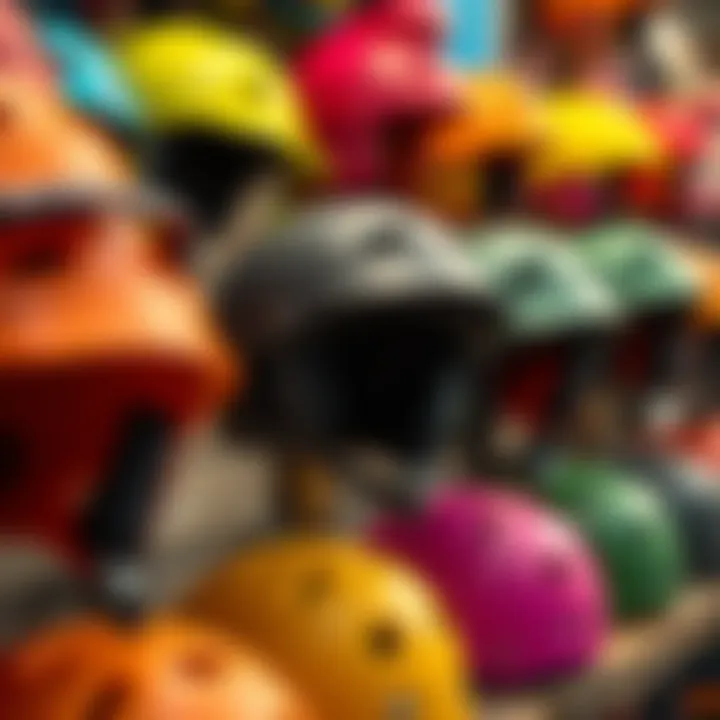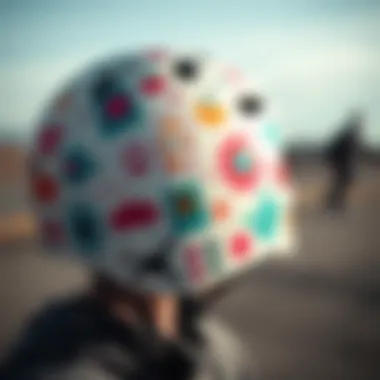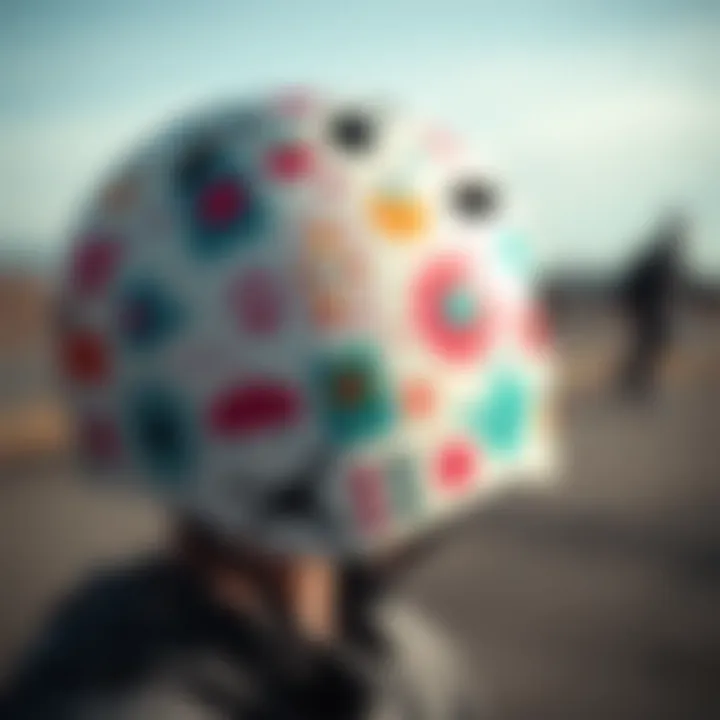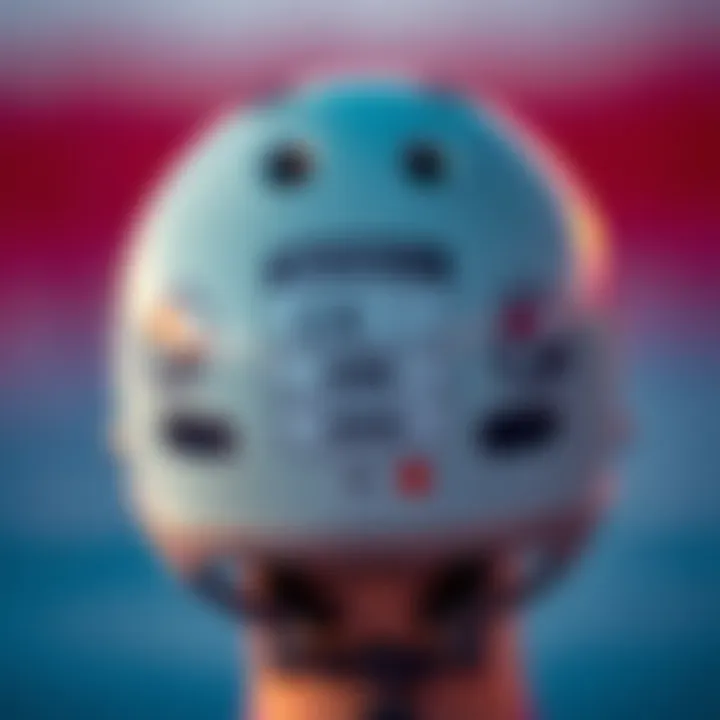The Allure of Adorable Skating Helmets


Intro
Skating has long been associated with freedom, movement, and sometimes a touch of rebellion. As enthusiasts take to the streets, parks, and rinks, an unexpected trend has emerged in the accessories they choose to wear: cute helmets. It's not just about safety anymore; it’s about style, personality, and making a statement. Cute helmets are quickly gaining traction among skaters, not merely as a protective gear but as a means of personal expression.
As we delve into the world of cute helmets for skating, this article aims to highlight several key areas. We will explore how design plays a pivotal role in appealing to users. The psychology behind why some skaters prefer stylized helmets over utilitarian ones will be examined closely. Safety standards are not being sidelined; rather, they are aligning with an aesthetic revolution. We’ll take a closer look at the materials used in these helmets and how they influence safety perceptions. Furthermore, we’ll discuss brand reputation and user preferences to provide a comprehensive understanding of this niche segment in skating gear.
In a culture where visuals matter, how a skater looks is as important as how they perform. This merging of functionality and style will be central to our exploration, ensuring that we paint a vivid picture of what these cute helmets represent in the skating community.
Intro to Cute Helmets
The blending of safety and style in sports gear is no longer a novel concept. In recent years, there has been a marked rise in the popularity of cute helmets, especially within skating culture. This section delves into the significance of cute helmets, exploring how their playful designs cater not just to aesthetics, but to the emotional and psychological aspects of helmet wearing. With a focus on youth engagement and self-expression, cute helmets make an ordinary necessity into a personal statement.
The Rise of Cute Designs in Sports Gear
It's hard to ignore the wave of vibrant and whimsical designs sweeping across the sports equipment landscape. Cute helmets have taken off like a rocket, thanks in no small part to the influence of social media trends and the ever-growing community of young skaters eager to stand out. In this digital age, the visual appeal of any gear can be a deal-breaker, turning heads on skate parks and during rides alike.
The rise of cute designs does more than merely appeal to a sense of fashion; it lures skaters to think of safety in a different light. The fear of injury diminishes when one can wear something that resonates with their personality. Additionally:
- Visibility and Identity: Bright colors and fun graphics draw attention, allowing skaters to express their individuality while ensuring other riders and pedestrians notice their presence.
- Creating Community: As more riders sport cute helmets, it fosters a sense of belonging and community among skaters who share similar tastes.
Defining 'Cute' in Helmet Aesthetics
When speaking of aesthetics, the term 'cute' varies widely among individuals. It can invoke warm and fuzzy feelings, often evoking nostalgia or a sense of playfulness. In the context of helmets, this differentiation is vital. Cute designs typically embody characteristics such as:
- Playful Color Schemes: Bright hues, pastel shades, and bold patterns create visually striking options that are hard to miss.
- Unique Shapes: Some helmets break the mold with unusual silhouettes or whimsical attachments, such as animal features or cartoonish elements that capture the essence of fun.
- Customizability: Options for personal stickers or decals allow skaters to take a basic helmet and transform it into something that reflects their own character and stories.
Ultimately, "cute" is about infusing personality into safety gear. For many skating enthusiasts, the aesthetics of their helmet can make all the difference in how they perceive their protective equipment. It's not just a shield against injury; it's an extension of who they are on wheels, enhancing the entire skating experience.
Understanding Safety Standards
Safety standards form the backbone of helmet design, especially as the interest in cute helmets surges within the skating community. These standards are not just regulatory red tape; they ensure that the helmets provide genuine protection during use. With many new users drawn to the sport by appealing aesthetics, it is crucial they’re shielded adequately against potential injuries.
In delving into safety, one can not overlook how vital it is to strike a balance between helmet charm and performance. Cute designs can attract skaters, but they must also meet rigorous safety criteria, guaranteeing the user's wellbeing. To comprehend the appeal of these helmets fully, it is important to understand the specific industry safety regulations.
Industry Safety Regulations for Helmets
The guidelines for helmet safety are set by several governing bodies, such as the Consumer Product Safety Commission (CPSC). These organizations lay out comprehensive standards for impact resistance, durability, and retention system effectiveness.
- Impact Testing: Helmets need to undergo tests that simulate falls and collisions, ensuring they can absorb force effectively. A helmet that performs well in these tests is likely to reduce the risk of head injuries significantly.
- Retention System: This component, which includes chin straps and padding, must adequately hold the helmet in place during impact. If a helmet slips off right when it's needed, its protective advantages are effectively nullified.
- Ventilation and Comfort: While not a safety standard per se, comfort contributes to user compliance. If a helmet is uncomfortable, users might skip wearing it altogether. A well-ventilated design can make a protective helmet more appealing, even if it boasts a cute aesthetic.
By adhering to these regulations, manufacturers can guarantee that their helmets not just look good but also serve their fundamental purpose—keeping heads safe.
Balancing Safety and Style
It’s often said that beauty is in the eye of the beholder, and this rings true for helmets in the skating world. Yet, merging style with safety isn’t always straightforward. Skaters crave personalization and flair, but they also need peace of mind knowing they are well-protected.
Finding a middle ground requires creativity from both designers and brands. Some strategies include:
- Innovative Materials: Using advanced materials like polycarbonate, which offers flexibility and strength, ensures helmets can take a hit without compromising design.
- Customization Options: Brands are starting to offer customizable decals or colors, allowing users to mix and match styles while benefiting from solid safety foundations.
- Awareness Campaigns: Educating skaters on safety’s importance while showcasing the fun aspects of wearing these helmets can shift perceptions. A helmet designed with flair can symbolize a lifestyle choice rather than merely a safety accessory.


The challenge remains a continuous dialogue between aesthetics and safety, yet it points toward a future where skaters can express themselves fully without sacrificing their protection.
"The fusion of playful aesthetics and serious craftsmanship marks a new era in helmet design, focusing equally on style and user safety."
Materials and Construction of Cute Helmets
The construction and materials used in cute helmets play a vital role not only in their aesthetic appeal but also in their functionality and safety. For those who skate, a helmet is much more than a mere accessory; it acts as a shield against potential injuries. As this trend of adopting cuteness in helmet designs becomes more popular, understanding what goes into making these helmets is crucial.
Common Materials Used in Helmet Production
When it comes to helmet production, the type of materials employed can significantly influence performance, durability, and the visual aspect lovers seek. Commonly used materials include:
- Polycarbonate: This lightweight thermoplastic is widely favored for its impact resistance. It ensures that even the cutest designs on the helmets remain durable while effectively safeguarding the wearer.
- EPS Foam (Expanded Polystyrene): Typically found inside the helmet, this material absorbs shock upon impact. The foam cradles the head, reducing the intensity of forces that travel through during an incident.
- Polyethylene: Another durable option, polyethylene boasts flexibility and provides an additional layer of protection without adding excessive weight.
Choosing the right combination of these materials allows manufacturers to strike a balance between safety and aesthetics, promoting the notion that a helmet can be both cute and effective.
The Role of Lightweight Designs in User Experience
Lightweight helmets have emerged not merely as a preference but rather as a necessity for many skaters. The user experience is heightened when the equipment they wear doesn't weigh them down. Here’s how lightweight designs enhance the skating experience:
- Comfort during Extended Use: A lighter helmet reduces fatigue during long skating sessions. Users can focus on their maneuvers without the constant awareness of added weight on their heads, which can be a distraction.
- Increased Maneuverability: Intuitive design helps enhance the skater’s performance. With a helmet that stays comfortably in place, skaters can turn and tilt their heads easily, pretty essential when performing tricks.
- Better Ventilation: Featherweight materials tend to allow for better breathability. With proper ventilation, skaters don't overheat, aiding overall comfort.
Exploring the design of helmets reveals that aesthetics aren't simply about visual appeal; they also intertwine with vitality regarding user performance and experience.
Market Trends and Demographics
Understanding market trends and demographics is crucial for grasping the full picture of why cute helmets are gaining traction among skaters. This section delves into the various elements affecting this niche market, such as consumer preferences, age groups, and cultural influences that shape demand. Not only does it shine a spotlight on buyer behavior but it also unveils how these trends reflect broader societal changes related to style, safety, and individuality.
Target Audiences for Cute Helmets
The appeal of cute helmets is multifaceted, attracting a diverse range of demographics.
- Young Skaters: Children and teenagers are likely the largest demographic targeted by brands. The playful designs resonate with their desire for self-expression and trendiness. Many young skaters have a growing appreciation for bold colors and whimsical graphics, which set them apart from more traditional gear options.
- Adult Enthusiasts: On the other side of the spectrum, adult skaters who want to embrace a youthful aesthetic also favor cute helmets. These individuals often seek a combination of safety and style, wanting gear that reflects their personality while still offering protection.
- Parents Buying for their Children: This group is another critical audience, as parents are increasingly purchasing gear that looks good, hoping it will entice their kids to wear protective equipment consistently. The cuteness factor plays heavily here; if a kid likes how it looks, they are more likely to use it.
- Lifestyle Influencers: Bloggers and digital influencers in the outdoor and skating community also significantly impact market trends. They often showcase their cute helmets on social media platforms, encouraging followers to choose fashionable options over standard designs.
This potpourri of audiences indicates a shift — from merely protective gear to fashion statements, these helmets cater to skaters’ evolving preferences.
Global Markets and Regional Preferences
The cute helmet market is not confined to a single geography; rather, it exhibits distinctive preferences across different global regions. For instance:
- North America: In places like the United States and Canada, colorful and quirky designs have seen a rise in popularity, especially among younger audiences. The influence of pop culture, particularly through platforms like Instagram and TikTok, has made certain designs trendy.
- Europe: In contrast, European markets may favor designs that blend minimalism with playful aspects. Countries such as Sweden and Denmark often promote functionality alongside aesthetic appeal, emphasizing eco-friendliness in materials used.
- Asia: Asian markets, particularly in Japan and South Korea, embrace cute culture to unprecedented levels. Helmets often incorporate characters or themes from anime and gaming, resonating deeply with the local youth culture.
- Australia: Down under, there is a mix of rugged and cute designs, often influenced by outdoor activities and a laid-back lifestyle. Australian skaters appreciate helmets that can withstand elements while still boasting a lively design.
This variation in demand illustrates the rich tapestry of consumer preferences, showing that while cuteness may be a unifying factor, execution is vastly different based on regional cultural context.
"Trends in aesthetics can often tell more about society than functionality, highlighting what consumers wish to project about themselves as they engage in their chosen activities."
The Psychology of Aesthetic Choices
The allure of cute helmets in the skating world transcends mere functionality; it delves deep into the psychology of aesthetic choices. This is not just about protecting one's head; it’s about identity, expression, and how we perceive safety. When skaters wear helmets adorned with whimsical designs or vibrant colors, their helmets transform from being a utilitarian object into a canvas for personal creativity.
For many, choosing a helmet is not just a practical decision but also an emotional one. The appeal lies in how these helmets resonate with their wearers’ personalities. Cute designs tend to evoke feelings of joy and positivity, which can shift the perception of safety itself. When skaters don helmets they find visually appealing, there is often an accompanying boost in confidence. This clever blend of style and substance can create a unique atmosphere where safety and self-expression go hand in hand.


Consider this: a brightly colored helmet with cartoon patterns not only draws attention but also sends a message—"I take safety seriously, but I can still have fun!" By consciously choosing a cute helmet, a skater signals an openness to blend safety with style. Mental associations are powerful. If a helmet looks fun, the likelihood of skaters feeling safe while wearing it increases.
- Identity expression: For young skaters, particularly, a helmet adorned with favorite characters or trendy motifs can serve as a form of social currency. It helps them fit in with their peers while making a statement about who they are as individuals.
- Safety enhancement: Studies suggest that individuals who perceive their protective gear as appealing are more inclined to wear it consistently. Thus, aesthetics can contribute to better adherence to safety norms.
This combination of emotional resonance and functional practicality makes understanding the psychology behind these aesthetic choices essential. It's not just fashion; it's a crucial component of the culture surrounding skating.
Influence of Visual Appeal on Safety Perception
Skaters often find themselves balancing the need for safety with the desire for style. Striking visuals in helmet design can significantly enhance how safety is perceived. A helmet that captivates the eye can decrease perceived risks associated with skating.
When a skater dons a helmet that catches their eye, it's almost like wearing a badge of honor. It becomes more than just a protective layer; it morphs into a piece of art that commands attention. For instance, a helmet featuring playful polka dots or an artistic mural can invoke a sense of pride in the wearer, reinforcing their commitment to safety while also ensuring they don’t look out of place in their skating community.
"The more attractive the helmet, the more likely a skater is to wear it, potentially translating into better safety practices."
Just as some athletes choose gear based on their favorite colors or brands, the visual appeal of helmets plays a critical role in encouraging consistent use. This correlation holds profound implications for safety, leading to a more substantial emphasis on protective practices among those who might otherwise shy away from the risk.
Cultural Trends Affecting Helmet Design Preferences
Cultural trends significantly shape the aesthetics of cute helmets in skating. As global influences shift, so do preferences in helmet design.
In recent years, the rise of social media platforms has transformed how young skaters view and select their gear. Helmets that stand out on Instagram or TikTok often gain a foothold in popular culture, encouraging brands to design helmets that not only protect but also impress visually. For instance:
- Social media influence: Designs or colors trending online can prompt manufacturers to quickly adapt their offerings, leading to a vibrant, ever-changing market for helmets.
- Celebrity endorsements: When notable figures in skating sport colorful or uniquely designed helmets, their followers are likely to mimic those choices, leading to increased demand for similar styles.
Additionally, regional preferences also play a great role in the designs favored by different cultures. In some areas, minimalistic or pastels may be all the rage, while others might lean towards striking and eclectic designs. Understanding these cultural nuances offers brands a better grasp of market demands, allowing them to tailor their products accordingly, ultimately enhancing user experience by aligning aesthetic offerings with cultural identity.
Brand Reputation and Marketing Strategies
In the realm of cute helmets for skating, brand reputation plays a pivotal role in consumer decision-making. A positive reputation not only builds trust but also influences purchase behaviors, especially in niche markets like this one. When skaters and parents shop for helmets, the brand's track record on safety, style, and community involvement can make or break a sale. This is particularly significant when cute designs are juxtaposed with the serious business of safety. People tend to flock toward brands perceived as dependable, as the voices of their peer networks echo in their minds.
Key Brands in the Cute Helmet Market
Several names dominate the landscape in this niche, each carving out a unique identity.
- Triple Eight: Known for their playful designs and robust safety standards, Triple Eight has created a strong following among skaters who appreciate both style and performance. Their helmets often feature bright colors and fun patterns, making them a favorite among younger audiences.
- Pro-Tec: A historical giant in the helmet industry, Pro-Tec offers a blend of classic designs with some newer, cuter models. Their helmets don’t just look good; they provide excellent protection backed by years of research and development.
- Nutcase: This brand stands out with its whimsical designs and appealing graphics aimed at both adults and kids. Nutcase's attention to aesthetics while focusing on comfort and safety has helped them secure a loyal customer base.
- Schwinn: Although they are traditionally known for bicycles, Schwinn’s expansion into the helmet market has been met with enthusiasm. Their cute, colorful helmets often feature popular cartoon characters and themes that resonate with children and their parents.
Effective Advertising Techniques for Niche Products
Promoting cute helmets requires a blend of innovative advertising strategies tailored to the lifestyle of potential users. Social media platforms like Instagram and TikTok have become vital for connecting with younger audiences who are not only interested in products but in the stories behind them. Here are some techniques that work effectively in this niche:
- User-Generated Content: Encouraging customers to share photos and stories about their experiences with cute helmets can create a sense of community. When potential buyers see real users enjoying a product, it fosters trust and authenticity.
- Influencer Collaborations: Partnering with popular skaters or lifestyle influencers can significantly enhance visibility. These individuals often have established audiences who trust their recommendations, making it easier to reach new markets.
- Social Media Campaigns: Running targeted ads on platforms like Facebook or Instagram can help reach specific demographics, such as parents looking for safe yet stylish helmets for their kids.
- Engaging Visuals: Utilizing eye-catching graphics and fun videos can draw attention more effectively than traditional static ads. Showcasing helmets in action, such as skaters gliding down a boardwalk, highlights the lifestyle aspect, making the product more appealing.
"A brand's reputation is built on its history among consumers; it's the silent ambassador in the marketplace."
- Limited Edition Designs: Highlighting exclusive designs or collaborations can induce urgency and excitement among consumers. Knowing that a product is limited can compel buyers to act quickly to avoid missing out.
By focusing on these strategies, brands can not only establish a strong foothold in the market but also nurture a community that passionately advocates for their products.
User Experiences and Testimonials
The world of skating already thrives on a culture steeped in style and personal expression, and cute helmets have carved out their own niche in this vibrant ecosystem. User experiences and testimonials are pivotal in understanding the shift towards cute helmets. These firsthand accounts not only provide valuable insights but also foster trust among potential buyers. When skaters share their stories, it reflects the real-world benefits and considerations that come into play when choosing headgear designed to marry safety with style.


By delving into personal experiences, we get to see how cute helmets impact not just the user’s safety but also their overall skating experience. Many skaters, whether pro or casual, lean towards these charming designs for reasons beyond simple aesthetics. It's about feeling good while doing something that often pushes the boundaries of personal capacity.
Real Stories from Skaters Using Cute Helmets
Take, for instance, the story of Maya, a passionate skater from San Diego. She often skated without a helmet until a close call during a trick made her reconsider. Maya opted for a pastel pink helmet adorned with fun stickers. "I never felt more confident on my board than I do now," she remarks, explaining how the helmet's cute design encourages her to skate more often.
Moreover, the positive feedback loop is noticeable: when she wears it, others notice, and it sparks conversations about safety and style, making her feel part of a community. It is not just about protection but also about the camaraderie that cute helmets can foster.
Another skater, Jared, hailing from New York, shares a different angle. He mentions how his vibrant blue helmet with quirky eyes on it became a conversation starter. "People not only compliment my helmet; they also share their own experiences and stories," he notes. This sense of belonging and shared narrative creates a richer context for the skating culture that goes hand in hand with safety gear.
Comparative Insights from Traditional Helmets
In contrast, opinions on traditional helmets often differ. Many skaters cite a lack of personality in standard designs, which sometimes leads to reluctance in wearing them. For example, traditional black or grey helmets can feel generic, causing users like Sarah to scramble for better options. "I used a regular helmet, and honestly, it was a bit of a drag. I’d wear it, but I didn’t feel like myself," she reflects on her transition.
Moving to a cute helmet not only upgraded her safety gear but also transformed her entire skating experience. The lively designs, bright colors, and personalized adornments lead to a more cheerful spirit while skating. Here’s a brief comparison based on user insights:
- Emotional Connection: Users of cute helmets often feel a stronger attachment due to the aesthetics. Traditional helmets lack this emotional resonance.
- Community Engagement: Cute helmets serve as a conversation starter, unlike their traditional counterparts, which often face ignorance in social settings.
- Mental Boost: Users report higher motivation levels when they sport helmets that align with their tastes compared to plain designs.
In summary, user experiences and testimonials underline the significant shift toward cute helmets. These stories, rich with personal anecdotes, reveal that while safety is paramount, the aesthetic appeal plays a crucial role in choosing headgear. With skaters sharing their vivid stories, it becomes evident that cute helmets are not just a trend; they're rapidly becoming a fundamental part of the skating identity.
Future Innovations in Helmet Design
The landscape of helmet design is evolving rapidly, particularly as the popularity of cute, aesthetic options for skating gains traction. The importance of future innovations in this realm cannot be understated. These advancements not only influence how users perceive style and safety but also integrate new technologies for enhanced functionality. As skating continues to be embraced by a wider audience, the pressure is on manufacturers to stay ahead of the curve with innovative designs that appeal to both safety-conscious and style-driven consumers.
Emerging Technologies in Helmet Manufacturing
The integration of emerging technologies in helmet manufacturing is paving the way for lighter, stronger, and more aesthetically pleasing options. From the use of advanced materials such as carbon fiber and polycarbonate blends to innovations in foam technology that increase impact resistance, the options are vast. These materials have a dual benefit: they ensure safety while allowing for the creation of whimsical designs that attract users ranging from children to adults.
- 3D Printing: This technology offers a new frontier for customized helmet designs. By allowing for unique shapes and patterns, brands can cater to niche markets seeking personalization.
- Smart Helmets: Integrating technology like built-in Bluetooth, audio systems, or even sensors that can track performance metrics adds a layer of fun and engagement. These features resonate particularly with younger skaters who are often keen on their gadgets.
- Eco-Friendly Materials: There is a growing trend towards sustainability. Companies are exploring biodegradable or recyclable materials to appeal to environmentally conscious consumers.
These technological advancements can make helmets not just safer but also a statement piece in skate fashion. As the integration of tech continues, it will be interesting to see how aesthetic preferences adapt in tandem with these innovations.
Potential Directions for Aesthetic Development
As safety features grow in sophistication, aesthetic development will likely follow suit. Cute helmets are not just about looking good; they need to resonate emotionally with the target audience. Here are a few potential directions:
- Playful Designs: Expect to see more vibrant colors and playful motifs that reflect popular culture. From cartoons to trendy patterns, these designs will captivate the younger audience while satisfying adult skaters who still possess a sense of whimsy.
- Customizable Elements: Innovations may allow users to swap out visor styles or even attach different accessories. This not only keeps the helmet fresh but enables skaters to express individuality.
- Cultural Inspirations: As skating is a global sport, cultural aesthetics might influence designs, allowing regions to put their own spin on how helmets are styled. This might mean the integration of traditional designs with modern materials, creating unique pieces that tell a story.
Embracing these innovative directions in both technology and design means that the future of skating helmets will be as much about personal expression as it is about safety. The interplay of cutting-edge features and appealing visuals will likely continue to captivate a diverse array of skaters.
Closure
As we wrap up this exploration of cute helmets for skating, it’s clear that these colorful and playful designs have carved a niche in the world of sports gear. Cute helmets do not simply appeal to aesthetic sensibilities; they are also changing how users perceive safety and self-expression. This makes understanding their significance all the more pertinent in today’s skating culture.
Summarizing Key Takeaways
Examining the journey of cute helmets, several key points emerge:
- Design Meets Safety: The integration of cute aesthetics with stringent safety standards illustrates a vital balance, making skating safer without sacrificing style.
- Psychological Impact: The allure of vibrant and whimsical designs can significantly influence users' perceptions of safety, encouraging more individuals to wear helmets.
- Brand Strategy: Recognizing the importance of branding, companies that embrace the cute helmet trend not only boost their market visibility but also connect with a broader audience, particularly younger skaters.
- User Experience: Positive testimonials underscore that wearers find the combination of safety and style personally rewarding, enhancing the overall skating experience.
The Lasting Impact of Cute Helmets on Skating Culture
Cute helmets are more than just a passing fad; they represent a shift in skating culture that emphasizes individuality and fun along with protection. As skaters choose helmets that speak to their personality, they foster a community where safety is not just a requirement, but a part of their lifestyle. This change is reflected in the gradual move from traditionally designed helmets to more vibrant options.
Furthermore, as social media platforms like Instagram and TikTok fuel the trend, the visibility of these helmets continues to rise, encouraging a culture that promotes both fun and safety. Skaters are more inclined to showcase their unique styles, which in turn leads to the acceptance and normalization of safety gear, establishing protective equipment as a valued part of their identity.
To sum it up, cute helmets for skating are not just practical items; they symbolize a progressive embrace of creativity and safety. They not only contribute to personal expression but also to a larger dialogue about safety in action sports. This evolution hints that we are not just witnessing a trend but a cultural shift that glorifies the marriage of style and security.



